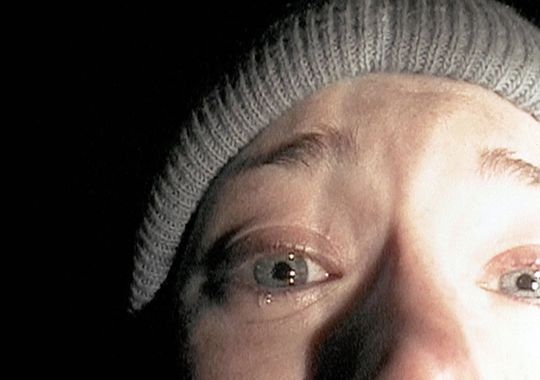This is part of a roundtable on The Best Band No One Has Ever Heard Of. The index to the roundtable is here.
___________
“I honestly thought we were like Joy Division, or early Pink Floyd, and if we took enough drugs and went dark enough we’d hit the pinnacle of art damage and that the world would stop.” So wrote Sean Madigan Hoen in 2006 in the liner notes for The Scar is Our Watermark, a compilation album for Thoughts of Ionesco, a Dearborn, MI-based noise/metal/whatever band he fronted from 1996 to 1999. Even for those readers who don’t immediately know what he is talking about, the arrogance of that sentence, both in style and sentiment, is practically suffocating. This was a band that started when he was barely out of high school and ended when his peers were barely out of college, a band whose notoriety was at once on a practically need-to-know basis up until very recently and often tangentially related to their actual creative output. Even Hoen himself is humbled by this. “How naïve,” he follows. And yet through it all, I can’t help but excuse him, not so much out of empathy as a creative person, but as someone who has tried anything in hopes of overcoming something worse.
That art is about struggle can seem rather meaningless when parroted as pure rhetoric or mantra, particularly by those who offer little evidence that they themselves have surffered. The artistic struggle is something that has to be presented as an example in order to be appreciated, if not understood; and audience as much as artist must be culpable in it in some way, whether as willing partners or as spiteful antagonists. This perhaps goes some way in assessing Thoughts of Ionesco and the rather unusual circumstances of their obscurity.
Rock fans often view the latter half of the 1990s to be the nadir of the genre, a cesspool even. Somewhere in between Weezer’s release of Pinkerton and Deftones’ release of White Pony, the metric of artistic quality in rock somehow got centered on The Goo Goo Dolls, or Matchbox 20. Soon enough one could hear the likes of Marilyn Manson and Billy Corgan declaring their wheelhouse all but dead. For a while it was difficult to tell which type of person was more annoying: the rich Chicken Littles or the fatalists who decided to stop worrying and love the backwards-capped bomb. In my old age, however, I should probably thank them. This idea that culture is a kind of Schrödinger’s cat, existing only when it is seen, will live as long as brute capitalism is the order of the day, and thank goodness for it, it may very well save lives.
Perhaps for a clever few, rock can be reinvented, but for most others it can at least be toyed with, leading to a free and natural flow of ideas almost flood-like in its power. This was never truer than it was in the American punk scene at the time. Whether out of sheer ambition or sheer boredom (both, I suspect), young musicians in basements and VFW halls were rekindling what was thought to have been conclusively extinguished with the advent of Bush. Subgenres that are now more or less commonplace took root in this activity; for a more detailed look at this period I recommend Jason Heller’s AV Club essay series Fear of a Punk Decade, for my purposes here I’ll be focusing on what is, for better or worse, the “metalcore” branch of the era, a melee in which Thoughts of Ionesco moved but neither thrived nor survived.
As an underground band, Thoughts of Ionesco clearly had the best possible timing to exist. Its lifespan coincided with Coalesce, Cave In, The Dillinger Escape Plan, Drowningman, Converge, Botch, Kiss It Goodbye, etc., bands that have shared venues with Thoughts of Ionesco, and bands that have gone on to become influential in their own rights, even classic. Their skills were not lacking in comparison. Though a three-piece, Thoughts of Ionesco had clear technical prowess that matched its primal power. Like Dillinger they had an ear for free jazz-influenced acrobatics, like Botch they could sustain a groove when the feeling caught them, and like Converge they had a scorched earth intensity. Their four albums were made quickly and cheaply (under $500 by Hoen’s estimation), but whereas most of their peers have one signature album regardless of longevity, Thoughts of Ionesco have two, thanks in part to their drummers: the aggressive founding member Brian Repa and the more virtuosic Derek Grant, who briefly substituted when Repa “lost his mind.” They play on For Detroit, From Addiction and A Skin Historic respectively.
1998’s A Skin Historic is an indulgent, blackly hedonistic album, born of a diet of The Birthday Party, King Crimson, Swans, Kyuss, John Coltrane, Norman Mailer, Henry Miller among others; its most apparent centerpiece is the contorted, relentless seven-minute opus “Upward, Inward, and Under.” Repa’s return brought them back to basics with 1999’s For Detroit, From Addiction, which came out of listening to Funhouse and driving “around the darkest parts of the city at night drinking Mickey’s and beating on [Repa’s] dashboard with our fists.” For Detroit does not necessarily boast any standouts compared to its predecessor, its uniformly hard-charging dynamic runs throughout the tracks basically demanding a complete listen, which is now made possible via iTunes or Grooveshark. The opening track “Learning an Enemy” is every bit as ferocious as its closing track “For an End.” “Waiting on Their War” backs off somewhat with a reflective first half before it, too, is riveted in frenzy.
Less approachable, however, are Thoughts of Ionesco’s lyrics, what Hoen describes as “very personal diatribes about self-violence.” With physical CDs of theirs hard to come by, and nothing much available online, we are left at the mercy of Hoen’s pained screams which evolved from guttural growls on A Skin Historic to the harried shrieks of For Detroit. Through that voice we are given utterances of sparing clarity, glimpses of an impulsive sort of vulnerability that we’re not supposed to know but that can’t really be helped in captivity. “I love the sickness that I am/I love the weakness that I am/The weight of your world can’t cut the skin I’ve made/I’m not alone/I am the sum of all pain,” he says on “The Scar is Our Watermark,” as far as I’m able to determine.
Then in 1999, Thoughts of Ionesco quit, just as The Dillinger Escape Plan released its game changing Calculating Infinity, and two years before Converge redrew For Detroit’s blueprint with Jane Doe and basically all their releases since. Nothing was heard of Thoughts of Ionesco for the next seven years, which seems to have been fine with the Hoen. “I spent many years disowning my involvement with that band,” Hoen told Revolver earlier this year. Hoen continued to pursue music of a more consciously mainstream kind before delving into writing. The winter of 2014 saw the publication of Songs Only You Know, a memoir detailing the tragic personal circumstances that propelled him into art as much about the art itself. What could not be said before is now coming out clearer than ever. “The band was an outlet for rage and sorrow, and there were moments of truly primal release,” he said in Revolver, “[I]f it’s only darkness you’re seeking, it will chew up your soul with unbelievable speed.” ;
“We weren’t scenesters, we weren’t punk,” the liner notes go on, “we were a small band of Detroit area rejects and depressives who meant every moment of it.” To put it with less bluster, however justified, Thoughts of Ionesco were artists, at least when compared to the artist-entrepreneurs that Dillinger, Converge, Coalesce and others became. “We didn’t want friends or lovers or regular jobs, just the music.” They showed a marked indifference to economics, choosing to work with small, local, barely solvent record labels. They toured under abject conditions with property damages as much a part of their expenses as gas or food. Pure art of Thoughts of Ionesco’s kind is expensive, as much emotionally and physically as it is financially. The specter of mental illness followed the band throughout their existence. Having not yet read Hoen’s memoir I can only irresponsibly speculate; I can say more certainly that they were one of the least inhibited bands to have existed in that era and not always to their advantage. Videos online show a band putting every bit of energy they have into exhibiting their damage, most notably Repa who became their Chuck Dukowski figure. This often led to literally causing damage, making them more of a spectacle than a performance unit. Destruction of instruments and other property is a contentious subject for musicians as a matter of vanity and practicality, yet in Thoughts of Ionesco’s case it’s an act fraught with anxiety.
Perhaps most expensive was the cost of sharing the art with others, a notion that the band approached with ambivalence at best, outright contempt at worst. In the course of its existence the band grew tired of its scene. The best known non-local bands they thank in The Scar is Our Watermark are the grindcore staple Brutal Truth and Coalesce, Thoughts of Ionesco’s more intellectual counterpart. For their later live shows they employed a saxophonist and played less frequently with hardcore bands. “Like their namesake … the band’s disconnect with the audience was a source of frustration,” wrote a reviewer for Lambgoat.com in 2006. When they finally stopped it seemed a moment of relief for everyone.
If there’s anything to be gotten out of Thoughts of Ionesco, aside from some notably wrenching music, it’s probably a lesson in costs, in art but also in authenticity. Authenticity is something that’s cherished by punk audiences—and Americans generally. The point, it seems, of each generation is to be more authentic than the last. Often these generations can or choose to do little more than to identify what is authentic and mimic it to the best of its collective abilities. We see as much thoughtful sincerity as we do righteous antagonism and blind nihilism from our heroes on stage. To a certain extent they believe, or at least they want to in a bad way. But things have a way of reining them in; commerce perhaps, or just classic good sense and propriety. Occasionally, though, if one believes deeply enough and asks repeatedly enough, one just might get what was asked for, provided the people who deliver it are the ones who pay.


